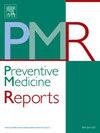锥度指数与胆结石疾病的关联:NHANES 2017-2020的横断面研究
IF 2.4
3区 医学
Q2 PUBLIC, ENVIRONMENTAL & OCCUPATIONAL HEALTH
引用次数: 0
摘要
目的圆锥度指数(C-index)与多种疾病的相关性得到认可。然而,c -指数与胆囊结石病(GSD)的关系尚未探讨。本研究旨在探讨c -指数与GSD患病率之间的潜在关系。方法利用2017 - 2020年全国健康与营养调查(NHANES)数据,通过调查加权多元logistic回归和限制性三次样条回归分析c指数与GSD的相关性。采用受试者工作特征(ROC)曲线分析比较c指数、身体质量指数(BMI)和腰臀比(WHR)的预测效果。结果本研究共纳入3626名受试者,c指数与GSD呈显著正相关。在完全调整后的模型中,c指数每增加一个标准差,GSD患病率增加30% (OR = 1.30;95% CI, 1.06 ~ 1.59;p = 0.036)。限制三次样条分析发现,c指数与GSD之间没有显著的非线性关系(p-非线性= 0.213)。与WHR相比,c指数对GSD的预测能力更强(p <;0.001),与BMI相当(p = 0.483)。结论c -指数与GSD患病率呈正相关,提示c -指数可作为早期发现胆结石的有价值的临床指标。本文章由计算机程序翻译,如有差异,请以英文原文为准。
Association between conicity index and gallstone disease: A cross-sectional study from NHANES 2017–2020
Objective
The conicity index (C-index) is recognized for its association with various diseases. However, the relationship between C-index and gallstone disease (GSD) has not been explored. This study aims to investigate the potential relationship between C-index and GSD prevalence.
Methods
Using data from the National Health and Nutrition Examination Survey (NHANES) spanning 2017 to 2020, we analyzed the association between C-index and GSD through survey-weighted multivariate logistic regression and restricted cubic spline regression. Receiver operating characteristic (ROC) curve analysis was utilized to compare the predictive performance of C-index, body mass index (BMI), and waist-to-hip ratio (WHR).
Results
The study encompassed 3626 participants and revealed a significant positive relationship between C-index and GSD. In the fully adjusted model, each standard deviation increase in C-index was associated with 30 % rise in the odds of GSD prevalence (OR = 1.30; 95 % CI, 1.06 to 1.59; p = 0.036). The restricted cubic spline analysis found no significant nonlinear relationships between C-index and GSD (p-nonlinear = 0.213). C-index demonstrated superior predictive power for GSD when compared to WHR (p < 0.001), and was comparable to BMI (p = 0.483).
Conclusions
This research establishes a strong positive association between C-index and GSD prevalence, suggesting that C-index could serve as a valuable clinical marker for the early detection of gallstones.
求助全文
通过发布文献求助,成功后即可免费获取论文全文。
去求助
来源期刊

Preventive Medicine Reports
Medicine-Public Health, Environmental and Occupational Health
CiteScore
3.90
自引率
0.00%
发文量
353
 求助内容:
求助内容: 应助结果提醒方式:
应助结果提醒方式:


